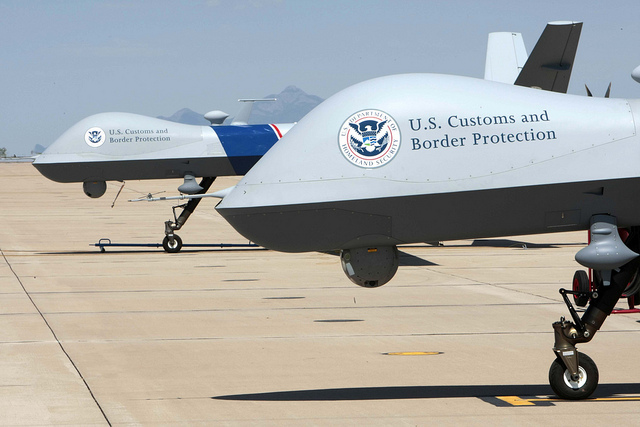U.S. Customs and Border Protection Considered Equipping Drones With Non-Lethal Weapons

 By Melissa del Bosque, Texas Observer
By Melissa del Bosque, Texas Observer
In the past three years, U.S. Customs and Border Protection has rapidly increased its use of drones for domestic surveillance, despite growing concern from civil liberties groups. But those drones may soon do more than just spy. A recently declassified government report reveals that the agency has also considered equipping its drones with “non-lethal weapons.”
“It’s the first I’ve heard of Customs and Border Protection considering using weapons,” says Jennifer Lynch, a staff attorney with the nonprofit Electronic Frontier Foundation, the group that obtained the government report on drones after filing a Freedom of Information Act lawsuit. “They’ve always said their Predator drones are unarmed and just used for surveillance.”
The non-lethal weapons would be used to immobilize “targets of interest,” according to the report. Most likely weaponized drones would be used for border security, Lynch says. “What the targets of interest would be are unclear. They could be people, facilities or cars.”
The report also doesn’t specify what non-lethal weapons the agency has in mind. U.S. Customs and Border Protection agents have been known to use rubber bullets and pepper pellets in their arsenal.
Despite the recent revelation, this is not the first time the use of weaponized drones has come up in the realm of border security. In a 2011 interview in the magazine El Paso Inc., former Democratic Congressman Silvestre Reyes, then chair of the Permanent Select Committee on Intelligence, said he wouldn’t rule out drone strikes in Mexico. “We have to do what we’ve done essentially in Pakistan, and that is start taking out the heads of the cartels,” he told the magazine.
Earlier in 2011, The New York Times revealed that the Mexican government was allowing U.S. Customs and Border Protection—under direction of the Pentagon—to fly drones deep into Mexico to conduct surveillance and gather intelligence on major drug kingpins.
Customs and Border Protection is also using drones to conduct surveillance for many other governmental agencies, especially state and local law enforcement, with scant oversight, Lynch says. She adds that the use of weaponized drones, even non-lethal weapons, on U.S. soil is cause for concern. “If they’re flying drones with weapons on them on behalf of other agencies in a program with little oversight—that really worries me,” Lynch says. “We’re going to start seeing weapons used for many different things.”
(Update: U.S. Customs and Border Protection spokesperson Mike Friel sent the following statement in response to the story: “CBP has no plans to arm its unmanned aircraft systems with non-lethal weapons or weapons of any kind. CBP’s unmanned aircraft systems (UAS) support CBP’s border security mission and provide an important surveillance and reconnaissance capability for interdiction agents on the ground and on the waterways. Current UAS were designed with the ability to add new surveillance capabilities, accommodate technological developments, and ensure that our systems are equipped with the most advanced resources available.”)
This article was first published in Texas Observer.
Melissa del Bosque joined The Texas Observer staff in 2008. She specializes in reporting on immigration and the U.S.-Mexico border. Her work has been published in national and international publications including TIME magazine and the Mexico City-based Nexos magazine. She has a master’s in public health from Texas A&M University and a master’s in journalism from the University of Texas at Austin.
[Photo by CBP Photography]
